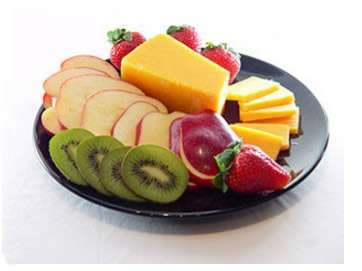K-State nutrition specialist urges portion control
MANHATTAN, Kan. – There’s good news for those who may question whether or not to grab a snack when their stomach begins grumbling sometime between lunch and dinner.
You have permission to snack on.
But Kansas State University nutrition specialist Sandy Procter said making a plan for what you eat – and how much of it – is key to providing the energy your body is asking for, and avoiding unwanted weight gain.
“Snacks happen,” Procter said. “It’s okay to be hungry between meals and to have a snack, but by controlling portions and planning ahead for what those snacks might be, you’re actually taking control and not just leaving it to chance, which a lot of times leads to extra calories.”
A study from the Harvard School of Public Health reported recently that nearly one-fourth of Americans say they snack multiple times per day, and at least one-third say they snack at least once a day.
“It’s pretty much an accepted part of our eating patterns,” Procter said.
The best snack options, Procter said, are those that provide a bridge between meals and healthful nutrients, yet don’t contribute significantly to the day’s total calorie count, which for most active American adults is 2,000 to 2,500 calories (2,800 for active teenagers).
Some good choices include:
• Whole grain crackers with a slice of cheese.
• Fruit or vegetables.
• A handful of nuts.
• Whole grain breadsticks or a leftover dinner roll, biscuit or muffin.
• A small salad.
• Whole grain cereal squares.
To make it more convenient to snack healthfully – at home, work or other places — Procter suggests using small zip-type bags or small reusable containers to store snacks, which also helps to prevent eating too much during snack-time.
“You certainly don’t want to eat so much that it interferes with your appetite for an (upcoming) meal,” Procter said. “You also want to be strategic about the choice of snack so that you’re eating it for a boost of energy or extra nutrients in your diet.”
This is not to say that foods higher in calories or fat – ice cream, anyone? – are off-limits at snack time.
“You probably don’t want to have those on a regular basis as part of your eating pattern,” Procter said. “If you do, you are likely going to put on weight. It’s just the way that calories work. It’s important that those exceptions are not a regular occurrence and that we are thoughtful about portion sizes.”
More information on healthy eating and nutrition is available online from K-State Research and Extension.
# # #
Sidebar
Tips for kids’ snacks
K-State Research and Extension nutrition specialist Sandy Procter shares some ideas to encourage kids to eat healthy snacks:
• Reserve a spot on a shelf in the pantry or refrigerator for healthy snacks. Kids will always know where to look when they need quick energy.
• Pre-package snacks in zip-type bags or reusable cups. This also helps to control the portion size that kids eat and makes snacks portable.
• Consider packaging smaller portions of appropriate leftovers for kids to snack on the next day, such as salad, fruit or roast meat.
Procter said appropriate snacks partly “depend on the age and tastes of your kids. Keep some of those things that are kid-specific on the shelves.”
She also recommends aiming to stock various healthful snacks: “(Kids) are going to snack on a variety of things. As a parent, you can’t be too heavy-handed…create the path of least resistance.”
-30-
FOR PRINT PUBLICATIONS: Links used in this story
K-State’s Department of Food, Nutrition, Dietetics and Health, www.hhs.k-state.edu/fndh
K State Research and Extension is a short name for the Kansas State University Agricultural Experiment Station and Cooperative Extension Service, a program designed to generate and distribute useful knowledge for the well being of Kansans. Supported by county, state, federal and private funds, the program has county extension offices, experiment fields, area extension offices and regional research centers statewide. Its headquarters is on the K State campus in Manhattan. For more information, visit www.ksre.ksu.edu. K-State Research and Extension is an equal opportunity provider and employer.
Story by:
Pat Melgares
785-532-1160
[email protected]
For more information:
Sandy Procter
785-532-1675
[email protected]





